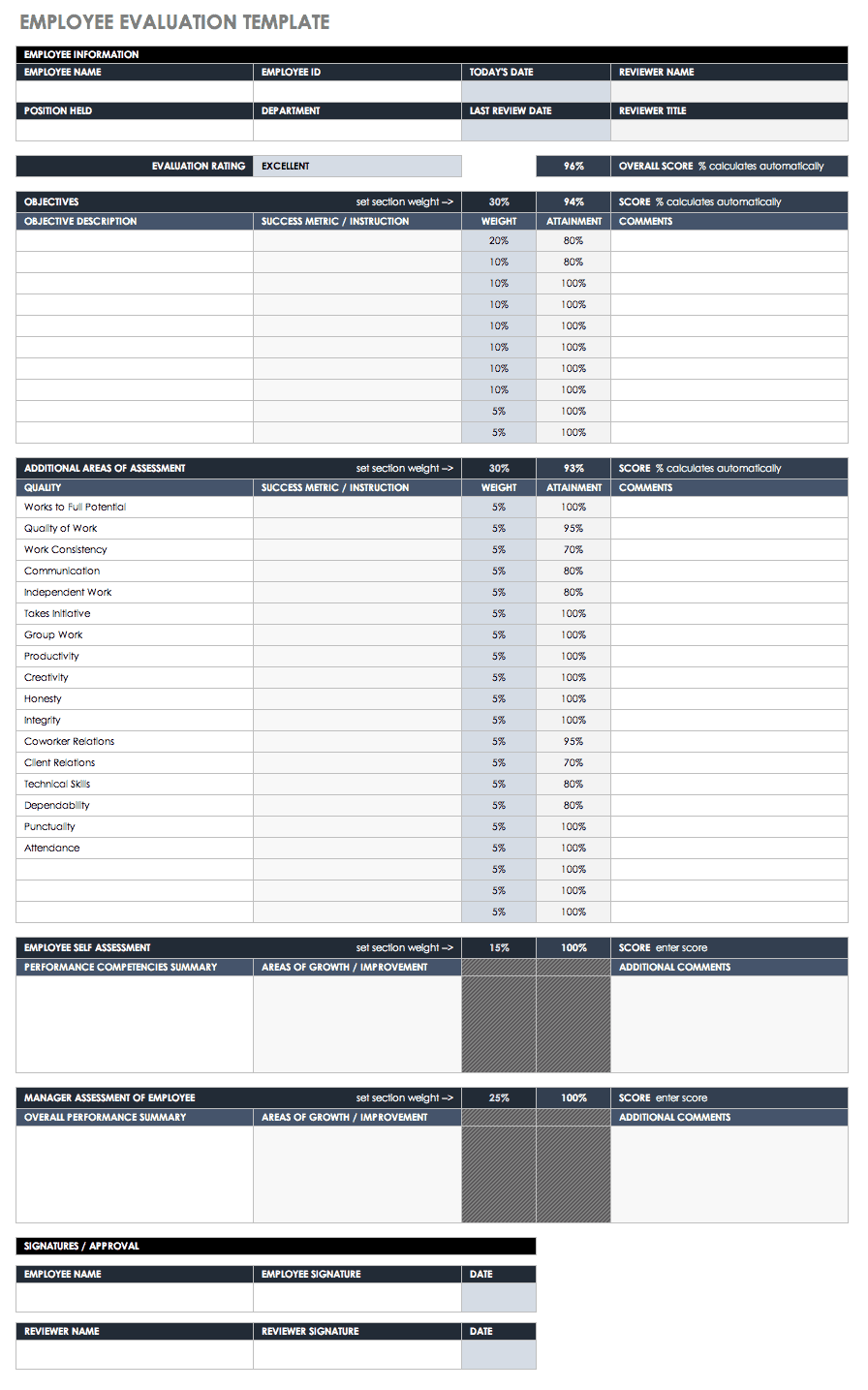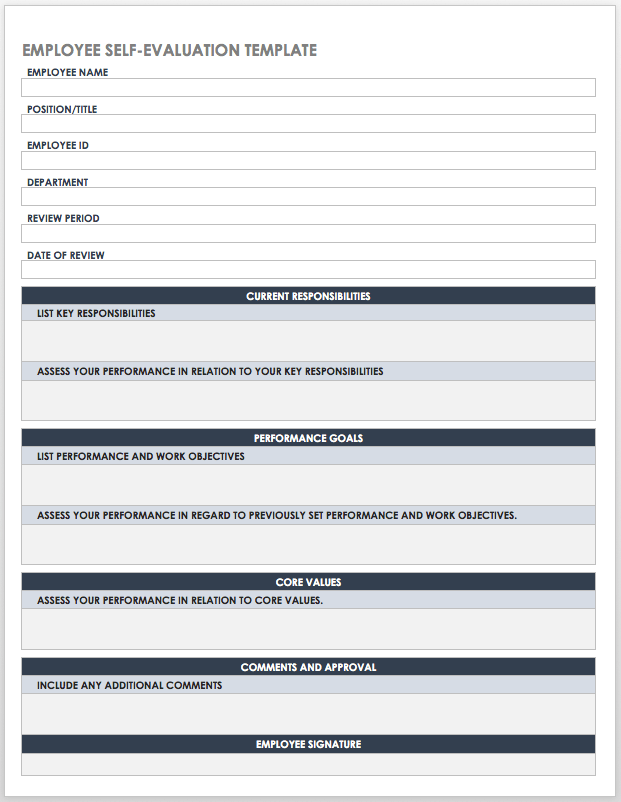What Is a Performance Review?
Before there were employee self-assessments, there were performance reviews. A performance review, also known as a performance evaluation, employee appraisal, or career development discussion, is a way to document and evaluate your job performance. It’s also an important process to develop staff to meet organizational and personal career goals. As Sam Walton, founder of Walmart advised, “Listen to everyone in your company and figure out ways to get them talking.”
Armstrong explains that despite their anxiety-producing reputation, “A performance review can be defined as a top management responsibility. It’s not an annual process, but an ongoing one, and a culmination of all the work-related conversations between employee and manager during the full performance period. When done well, it’s an objective way of determining employee performance quality in alignment with predetermined expectations and a tool to illuminate work achievements, set new goals, and develop new responsibilities.”
How Do You Conduct a Performance Review?
There are no set rules for conducting employee performance evaluations — they can be written documents or in-person interviews. There are many options available and most organizations design or adapt their process based on their priorities and culture.
“Some organizations have annual reviews, some do it twice a year, some do it quarterly, and some do it monthly,” explains Cadigan. “Some use ratings, some don’t. Some share the ratings with employees, and others do not. Some tie it to compensation, and some don’t, [saying] it is for development only. Some people focus more on strengths while others focus reviews more on areas for improvement. Some use paper, and some do the process online and very lightweight. I have seen some companies use weekly one-on-one meetings as their performance reviews as an ongoing process. Some companies require 360-degree or 180-degree reviews — some just use the manager. I have also seen some companies stack rank people as part of their review process.”
Armstrong doesn’t see many cookie-cutter approaches in her practice. “I think a company needs to decide what works best for them,” she says. “However, less cumbersome forms and simple procedures are definitely recommended and appreciated. Many companies are moving to online tools for managing performance. The bottom line is to make sure that managers are talking to their direct reports on an ongoing basis. Making a habit of giving feedback frequently can result in a solid, healthy working relationship.”
For a look into performance reviews from your managers perspective, details about different review styles and processes, and ideas to help you create an outstanding self-assessment, read How to Write a Performance Review in the Least Amount of Time: Performance Review Tips, Phrases, and Comments.
What’s the Point of Performance Reviews?
Performance reviews serve multiple purposes and make good business sense for companies interested in employee retention and engagement. In fact, a Gallup research study found that regular employee feedback lowers turnover rates by 14.9 percent.
“Organizations need a formalized process to provide feedback to their employees,” says Jerez. “Employees need feedback to stay motivated, improve, build effective leadership skills, identify promotion-worthy accomplishments, and more. The process ideally allows for a two-way conversation between employee and manager with the intention of setting the tone for the year ahead.”
“Annual performance review — three words that frequently strike terror into the hearts of team leaders and team members alike,” says Stephens. “It’s a shame since the principles of performance reviews are sound: the need for organizations to be clear on what they expect and for employees to understand how they are doing and be recognized when they are doing well. Bad performance reviews are a lost opportunity as one-to-one discussions are precious and, when done well, can be the jewel in the line manager’s communication crown.”
At most companies, performance reviews are still essential communication and evaluation tools that support personal and organizational progress.
What Is a Performance Review Self-Assessment?
Self-assessments are now a prevalent part of the employee review process: Employees write and submit them to HR or their manager before the actual review meeting. Self-assessments inform managers of how you understand your place within the company’s organization and culture. Self-assessments also offer the opportunity to share your thoughts about your job, goals, and desired responsibilities. Performance reviews are a crucial channel of communication and include constructive feedback.
The Reality of Self-Appraisal
It’s important (and inevitable) that employees understand how their managers’ perception of their performance differs from their own. How you assess yourself helps pinpoint variances that may not otherwise come to light. More fruitful discussions and fair performance ratings can result when the manager has your self-assessment in advance of a review meeting. Your self-appraisal can guide or pivot your manager’s perception and assessment.
The Benefits of Self Evaluation for a Performance Review
Self-appraisals are your opportunity to show your employer that you take your job and career seriously. In a self-appraisal, you take responsibility for your own performance and have a stake in making progress occur. Facing down your demons and what you could have changed can be uncomfortable, but it’s still preferable to relying solely on your supervisor's estimation.
Scary as they might be, there is some good news about self-appraisals:
- Autonomy and Development: This is the time to take charge of what you say about your work and how you want to move your career forward.
- Share Your POV: Most team members and managers are working hard to get their tasks done and often there isn’t time to connect. The self-appraisal is your opportunity to share your ideas about how you fit in the team and work environment.
- Reminders of Achievement: Working managers often don’t have time to micromanage, and tend to be more aware of problems they need to handle. Self-appraisals are your chance to note your successes and how you add value.
- Meeting of the Minds: Self appraisals are also an opportunity to identify any discrepancies between how you and your supervisor view your performance and mutually agree on the reality of your performance.
- Improved Relationship: Communication is the pathway to more trust and understanding that can ultimately help how you and your manager work together in the future.
- Greater Engagement: If you know your manager wants to provide support and mentorship, you’ll be more invested and happier in your work.
- Ongoing Focus: Track your successes and challenges throughout the year. Being armed with this data when your performance review rolls around lowers stress and prevents you from writing last minute self-appraisals that don’t benefit you or the manager.
Ultimate Preparation: Your Career Map and Professional Development Plan
Armstrong suggests that both employees and managers have an eye on their career map and professional development. “Make sure that your boss genuinely cares about your development,” she advises. “If you feel that’s lacking, discuss it with your manager in your reviews.”
Professional Development Template - Word
Work on a professional development plan with your manager to drive your personal goals and align them with the organization’s. Use this template to outline specific goals and create a potential action plan to reach them. There are sections for noting further training needs, the purpose of each objective, action steps, necessary support, and a timeline — these are particularly useful when developing a plan. Goals are allocated to specific time frames to address today’s needs as well as future professional progress.
Download Professional Development Plan Template - Word
Career Planning Points
Improve your chances of cultivating the career you want by taking some time to plan. Supportive managers can help you identify the next steps on your path if you know where you want to go. Performance review meetings are a good place to get the conversation about your future started. Here are some things to consider:
- Your 5, 10, and 15 Year Outlook: You can’t get anywhere if you don’t know your destination. Understand the skills, personal characteristics, experience, and knowledge you need to move laterally, or to be be promoted or transfer to another department within your company (or elsewhere) to fulfill your ambitions.
- Know Your Business Value: Are you making the company more profitable and/or efficient? Is what you do essential to the company’s success?
- Ask for Manager Support: A manager can help you identify possible development opportunities. What are the next steps in your professional development? Do you need more coaching, mentoring, classes or volunteering experience?
Preparation can help ensure that you and your manager go into reviews knowing what to address. One way to do this is to create documentation that’s easy to update, access, and share. If you need some tools to prepare and simplify the process, look at Free Employee Performance Review Templates where you’ll find resources like this:
Employee Evaluation Template - Excel
Think about your self-evaluation from your manager's point of view. You can use this customizable form to compare your own performance to job requirements and measurable objectives. In addition, there’s space to note professional development plan ideas. You can also use it to collect your performance data against your job description between reviews.
Download Employee Evaluation Template
Don’t Procrastinate: Common Excuses for Putting Off Your Written Performance Review Self-Assessment
People tend to delay working on their self-appraisals until the last minute because it can be daunting to look in the mirror and evaluate your performance. A quality self-appraisal process takes time, and may even require writing a few drafts. If you don’t give yourself the adequate time to write it, you may skip recording achievements, avoid mentioning the support you need to be more successful at your job, or miss an opportunity to make a logical argument to gain a new position and move your career forward.
Below are some typical excuses and their remedies:
- “I’m too busy.” Lack of time isn’t an acceptable excuse if the self-appraisal is expected. The answer is to keep notes throughout the year about achievement and hurdles so you won’t experience the last-minute crunch.
- “No one uses self-evaluations anyway.” Take the time to ask your manager (if you haven’t been informed) about how your written self-appraisal will be used in your performance review. This insight will help you understand the utility of the self-assessment and give you hints for undertaking your own write-up.
- “I have no idea where to begin.” For employees who feel unequipped to self-evaluate, there are resources (including many at the end of this article). This is also a communication issue — you should be able to go to your manager or human resources department for guidance if the process at your organization is unclear.
- “It’s not my job to do this.” Maybe you’re just...lazy? It is your job if your manager has asked you to do it.
What to Avoid in Self-Assessments
Take some time to gauge how you’re communicating the great, good, and so-so aspects of your performance. “Employees should avoid focusing only on where their performance is good and glossing over or ignoring where they can improve,” says Abudi. “But more importantly, the employer – or manager – should not use employee’s self-assessment against the employee. Self-assessments shouldn’t be used to build out the entire performance review or to determine when an employee should not get a promotion or a raise or a bonus.”
Self-Assessment ‘Don’ts’ to Consider:
- Focusing Only on Achievement: Everyone has something to improve in their work life. A 100 percent glowing assessment of what you’ve done can raise alarm bells for your manager.
- False Modesty: The other side of the coin is soft-pedaling what you’ve done and attributing it only to teamwork, luck, or worse, not pointing achievements out at all. Be proud of your accomplishments and spell them out explicitly.
- Focusing on Weakness: While everyone has weaknesses, they are never the sole aspect of a person’s performance. If you have things to work on, frame them positively and as an opportunity for growth.
- Colleagues Are Off-Limits: This is about you and your accomplishments. Leave your team members out of your comments in writing and during the in-person meeting.
- Vagueness: Back up your assertions with measurable objectives and examples, especially if there are set metrics in your organization.
Writing a Solid Self-Assessment
The ongoing self-assessment themes our experts mentioned are to track accomplishments on an ongoing basis and to use self-assessment as an opportunity for open communication and to uncover aptitudes and skills for yourself and your manager.
“Self-assessment – where people review themselves – can be powerful, provided that [people] have a clear framework to measure themselves against, such as a role or competency profile,” says Stephens. “Otherwise, they may focus on what is important to them and not necessarily the role. Also, many of us can be heavily self-critical, so we have found that self-assessment is a potent part of the review process if it is tempered by a boss and/or peer who can provide an external take.”
“The key to self-assessment is not assessing yourself, but rather the outcome and what the product looks like versus what you understood what it was supposed to look like,” says Davis. “The primary value of self-evaluation is enabling the manager to see how employees take the task parameters/specs and run with them. This can help to identify both hidden talents of employees (if they [do] it better than expected) and miscommunications.”
Davis suggests writing down answers to the following questions to help in your self-assessment:
- How was the deliverable supposed to look?
- How is your deliverable even better than it was supposed to be?
- How else could the deliverable have been better than it was supposed to be?
- Are there any ways in which the deliverable may have fallen short of expectations?
“In every case above, this is all meant to open up the discussion, not to be the final answer,” says Davis. “No Q/A set is going to do anything more than start the right conversations. It's important to remember that any performance review tool is about starting a conversation, and not to be the last word (the latter is one of the biggest misuses of evaluation tools/techniques — they are worthless without the in-depth conversation).”
In addition to Davis’ approach, consider these ideas for a successful self-assessment experience:
- Relax: Take a deep breath and understand that your self-assessment is just one aspect of your performance review. Be kind to yourself.
- Prepare: Make sure you know what your manager is looking for before you even begin working on the written evaluation. Know how and why your manager will use the self-assessment. Next, review your job description. Match it to what you actually do and what you have accomplished. You may need to talk to your manager about adjusting your job description to align with your real duties. Ask yourself the hard questions about how you carry out your assignments, not just about completing them, but also about timeframes, teamwork, and how you have contributed in a way that adds value.
- Enlist an Objective Reviewer: Once you’ve completed your self-assessment, have a friend review the written assessment and then if you can, role play with your colleague or friend to make sure you’re prepared.
- Collect Kudos: If you receive compliments from colleagues or customers, be sure to collect them and note them in your self-assessment.
- Be Honest: Use the word “I” in your self-assessment document, and include the accomplishments you’ve tracked over time for consistent and specific data. Highlight and take pride in your accomplishments. Identify your work priorities over the past year based on your goals and objectives, discussions with your supervisor, or tasks. For each priority, describe your work and accomplishments. Incorporate feedback you’ve had and archived from previous assessments.
- Be a STAR: Consider actions to highlight based on these concepts: one of a kind, first‐time, high‐visibility, the degree of difficulty, a large volume of work, deadlines, scope and impact, competing priorities, and innovation required. Highlight your accomplishments by creating your own (brief) case studies using this format:
S: Describe the situation.
T: Outline the tasks.
A: Cover the action(s) you took to complete the work.
R: Explain the results you achieved.
Here’s an example of a STAR self-assessment case study:
When I was hired as a team manager, employee turnover rates were 20 percent every year. I designed and implemented a retention plan, beginning with a SurveyMonkey employee questionnaire and suggestion program, mentoring and coaching programs, and bi-weekly team meetings and bi-monthly team building activities. As a result of my efforts, turnover is now at eight percent.
- Professional Development: Stay attuned to a growth mindset. Think about what you want to improve to be an even better contributor and grow professionally, and what you need to improve (mentoring, classes, etc.). Share your challenges and work with your manager to find solutions. Don’t harp on challenges as weaknesses.
- Differentiate Yourself: Be your own advocate. Maintain professionalism in your presentation. Check grammar and spelling in your document. Be concise. Point out how you have provided value to the manager and the organization. Keep the focus on you — now is not the time to complain or compare yourself to colleagues. Be sure to cover the outcomes of the work you have done since the last review.
- Welcome Feedback: Ask and be open to feedback. Show how you have responded to feedback from previous reviews. If you have differing opinions on performance, it likely means that you’re not meeting often enough with your manager. Ask for more frequent communication for an ongoing, open dialogue. Leverage your job promotion opportunities by asking what is takes to get to the next level or reviewing your career map.
Words, Phrases, and Examples to Use for a Stellar Performance Review Self-Assessment
In your written self-assessment or in-person performance review, carefully chosen words can make all the difference. Always be positive, whether you’re covering achievements or challenges.
Categories and Words to Consider:
- Attitude: Dedicated, loyal, reliable, flexible, energetic, initiative, decisive, volunteer, ethical, fair
I demonstrated leadership by being decisive and assembling all the pertinent data and consulted with other team members as part of our process. I have a track record this year of 25 percent expedient decisions.
- Communication and Interpersonal Skills: Empathetic, cooperative, persuasive, team player, open-minded
I helped five junior team members gain new skill levels to take on new responsibilities. I expanded the scope of our department through careful delegation and designed a system of authorized responsibilities to ensure coverage in all situations.
- Creativity and Innovation: Receptive, problem solver, original, innovator, designer, original
I brought fresh and new ideas to each project and developed marketing concepts that won 20 percent more new clients. I also reduced time spent on projects by 15 percent by designing a new review and sign-off procedures.
- Accomplishments: Accurate, thorough, productive, goal attainer, unstoppable
I have a 70 percent success rate record for anticipating possible problems with procedural changes and I developed contingency plans in advance. I translated organizational goals into departmental tasks with a 95 percent success rate.
- Areas for Improvement: Skill building, professional growth, career plan
To support the company’s continuous improvement efforts, I’d like to broaden my skills further and obtain Lean Certification.
Still at a loss for words? The following resources are written from the manager’s point of view and illustrate what leaders look for in performance. The words and phrases can easily be adapted to work for employee self-evaluations.
Use A Template to Create Your Performance Review Self-Assessment
Many companies will provide an electronic template or format for the self-assessment that aligns with company policy, culture, goals, and job level. If your company doesn’t provide one, you can use this easy-to-adapt template to write or compile ongoing notes about accomplishments, goals, and professional development ideas.
Employee Self-Evaluation Template - Word
More than just a formality, self-evaluations can be meaningful tools. A self-evaluation can be part of a collaborative effort to define objectives and expectations that align with your personal goals and what your company requires for success. This open-ended self-evaluation form has a flexible outline to delineate responsibilities, assess performance, and plan performance objectives.
Download Employee Self-Evaluation Template
After the Self-Assessment and Performance Review: Think Ahead
You’ve completed your self-evaluation and had your performance review with your manager. You can breathe a sigh of relief. But don’t wait until the next review rolls around to take action. All the experts in this roundup emphasized ongoing self-evaluation and collecting your own performance data and proof of your achievements — this is crucial not only to make your next review painless but also to consider whether the job you have now is the right one or if it’s time to move on.
Next Steps:
- Begin Now: Start preparing for your next review immediately. Begin keeping tabs on all of your success and challenges as they happen.
- Manager Support: If your manager is willing and able to work with you on professional growth opportunities, make sure to get started as soon as possible. If you aren’t getting what you need to do your job well or to move up the career ladder, you may need to rethink your position.
- Career Plan Review: Where do you want to go? As a result of your latest review, do you think that you're able to meet your goals in your present job, or do you need to make a shift? Perhaps you need to realign your career map after you’ve had input from your manager about your current performance.
- Next-Level Action Steps: Where do you want to go? Career coaches can help point out a path, especially if you’re at mid-career and want to make a change. Networking outside of your organization may provide you with insights into ways to do your job better, or get you to the next level beyond your current position.
- Update and Use Social Media: If your LinkedIn or professional association social network information is out-of-date, now is a good time to polish your profile. Social engagement can also give you access to professional growth classes, opportunities, and involvement with people who can support your career plans.
- Resume Update: You should know where you stand after your performance review. If you’re thinking about the next job within the organization or at a new company, always keep your resume updated.
Career Building Resources
Use these resources to get to the next level whether you’re at the beginning or middle of your career, or if you’re thinking about making a change.
Books
- Career Anchors: The Changing Nature of Careers Self Assessment 4th Edition by Edgar H. Schein and John Van Maanen
- Finding Your Career Path without Losing Your Mind: Emotional Management for Job Seekers and Career Changers by Michal Fisher
- How To Write a Better Self-Evaluation: A guide to self-evaluations for people in the REAL WORLD! By Jennifer Rankin
- No More Ramen: The 20-Something's Real World Survival Guide - Straight Talk on Jobs, Money, Balance, Life, and More by Nicholas Aretakis
- 3000 Power Words and Phrases for Effective Performance Reviews: Ready-to-Use Language for Successful Employee Evaluations by Sandra E. Lamb
Articles & Free Online Tools
- Best Free Career Assessment Tools by Catherine Conlan
- Find the Career Coach That’s Right for You by Dorie Clark
- How to Do a Self-Assessment of Your Skills by The Guardian
- Take Charge of Your Own Career Planning by John Rossheim
Organizations
Track Your Work Achievements with Smartsheet for Painless Performance Reviews
Empower your people to go above and beyond with a flexible platform designed to match the needs of your team — and adapt as those needs change.
The Smartsheet platform makes it easy to plan, capture, manage, and report on work from anywhere, helping your team be more effective and get more done. Report on key metrics and get real-time visibility into work as it happens with roll-up reports, dashboards, and automated workflows built to keep your team connected and informed.
When teams have clarity into the work getting done, there’s no telling how much more they can accomplish in the same amount of time. Try Smartsheet for free, today.








